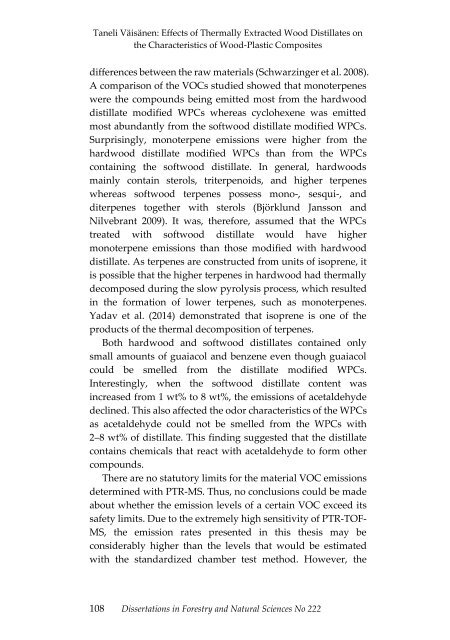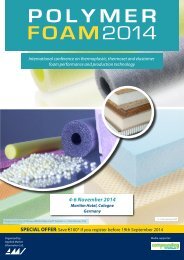Dissertations in Forestry and Natural Sciences
24lYKFN
24lYKFN
Create successful ePaper yourself
Turn your PDF publications into a flip-book with our unique Google optimized e-Paper software.
Taneli Väisänen: Effects of Thermally Extracted Wood Distillates on<br />
the Characteristics of Wood-Plastic Composites<br />
differences between the raw materials (Schwarz<strong>in</strong>ger et al. 2008).<br />
A comparison of the VOCs studied showed that monoterpenes<br />
were the compounds be<strong>in</strong>g emitted most from the hardwood<br />
distillate modified WPCs whereas cyclohexene was emitted<br />
most abundantly from the softwood distillate modified WPCs.<br />
Surpris<strong>in</strong>gly, monoterpene emissions were higher from the<br />
hardwood distillate modified WPCs than from the WPCs<br />
conta<strong>in</strong><strong>in</strong>g the softwood distillate. In general, hardwoods<br />
ma<strong>in</strong>ly conta<strong>in</strong> sterols, triterpenoids, <strong>and</strong> higher terpenes<br />
whereas softwood terpenes possess mono-, sesqui-, <strong>and</strong><br />
diterpenes together with sterols (Björklund Jansson <strong>and</strong><br />
Nilvebrant 2009). It was, therefore, assumed that the WPCs<br />
treated with softwood distillate would have higher<br />
monoterpene emissions than those modified with hardwood<br />
distillate. As terpenes are constructed from units of isoprene, it<br />
is possible that the higher terpenes <strong>in</strong> hardwood had thermally<br />
decomposed dur<strong>in</strong>g the slow pyrolysis process, which resulted<br />
<strong>in</strong> the formation of lower terpenes, such as monoterpenes.<br />
Yadav et al. (2014) demonstrated that isoprene is one of the<br />
products of the thermal decomposition of terpenes.<br />
Both hardwood <strong>and</strong> softwood distillates conta<strong>in</strong>ed only<br />
small amounts of guaiacol <strong>and</strong> benzene even though guaiacol<br />
could be smelled from the distillate modified WPCs.<br />
Interest<strong>in</strong>gly, when the softwood distillate content was<br />
<strong>in</strong>creased from 1 wt% to 8 wt%, the emissions of acetaldehyde<br />
decl<strong>in</strong>ed. This also affected the odor characteristics of the WPCs<br />
as acetaldehyde could not be smelled from the WPCs with<br />
2–8 wt% of distillate. This f<strong>in</strong>d<strong>in</strong>g suggested that the distillate<br />
conta<strong>in</strong>s chemicals that react with acetaldehyde to form other<br />
compounds.<br />
There are no statutory limits for the material VOC emissions<br />
determ<strong>in</strong>ed with PTR-MS. Thus, no conclusions could be made<br />
about whether the emission levels of a certa<strong>in</strong> VOC exceed its<br />
safety limits. Due to the extremely high sensitivity of PTR-TOF-<br />
MS, the emission rates presented <strong>in</strong> this thesis may be<br />
considerably higher than the levels that would be estimated<br />
with the st<strong>and</strong>ardized chamber test method. However, the<br />
108 <strong>Dissertations</strong> <strong>in</strong> <strong>Forestry</strong> <strong>and</strong> <strong>Natural</strong> <strong>Sciences</strong> No 222



